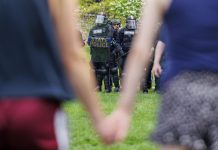More than two dozen Columbus residents gained new insight about the challenges police face when deciding when to use force — including four who now have some idea of what it’s like to shoot a suspect.
The four who participated in a simulated scenario were among 30 who attended the ongoing “Improving Police and Community Relations” discussion Saturday at Columbus City Hall, sponsored by the African American Pastors Alliance.
During the presentation titled “Use of Force,” audience volunteers Stella Collins, Ann Jones, Frank Griffin and Wan Baba were briefed on proper police procedures and possible scenarios involving use of force.
While acting out a scenario involving a bar brawl, all four ended up shooting (blanks) at a man who approached them in a confrontational manner.
[sc:text-divider text-divider-title=”Story continues below gallery” ]
However, all failed to realize that the man did not have a weapon, nor had he committed any crime other than disregarding an officer.
Baba said she was prepared to fire after experiencing an earlier exercise where a suspect did have a gun — and shot her before she could draw her weapon.
“You think you know what is going to happen, and you have to defend yourself,” Baba said after the scenario concluded.
While understanding the purpose of the exercise, Baba still expressed reservations about the circumstances.
“I was only given a gun,” Baba said. “I would have used a Taser if I had one.”
Likewise, Griffin felt the officers made their point, but only to a degree.
“Instantaneously, you think about self-preservation,” Griffin said. “But I hope our officers are much more trained than I am to handle this situation.”
After firing at the suspect after he only took a few steps toward her, Collins — the president of the Columbus/Bartholomew County Area Branch of the NAACP — admitted she acted in error.
“The perception was there that he had a gun, but I didn’t see it,” Collins said. “When his hand went up, it was an automatic reflex.”
The exercise taught the importance of paying attention to all details and “making sure you see what you think you see,” Collins said.
Audience members provided several alternatives to deadly force during the interactive program led by two Indiana State Police troopers, Capt. Ruben Marte’ and Maj. Todd Smith. But both professional lawmen said those alternatives have their drawbacks:
Taser guns are only effective half the time
Some suspects have a natural resistance to pepper spray
Police dogs aren’t always there when you need them
Shooting for legs or hands increases the odds of missing and being shot yourself
“You shoot to stop the threat,” said Marte’, who said protecting innocent lives is every officer’s first priority, followed by his own safety and then the suspect.
Legally, there are only a few situations in Indiana where an officer is permitted to use deadly force, Smith said. They are:
When the officer has probable cause to believe a suspect poses a significant threat of death or serious physical injury to the officer or others
When the officer has cause to believe the suspect is about to commit a forcible felony
But just as an officer can get in trouble for an unjustified shooting, he or she also can be disciplined if they let a dangerous suspect get away.
“Whether you act or don’t act, you will have to articulate your actions — and do a lot of explaining — to your superiors,” Marte’ said.
“It’s a no-win situation for that officer,” Bartholomew County Sheriff Matt Myers said in agreement.
Three real-life videos taken from dashboard cameras installed on police cruisers were used to illustrate how complicated real-life situations can be for an officer to judge in just a few seconds.
Once involved a June 2011 event in San Joaquin County, California. After the video seemed to show an unarmed Hispanic man being shot 11 times by an officer while getting out of a pickup truck, the 30 participants unanimously thought it was an unjustified shooting.
Then, Smith gave more details not visible from the video. The man who was fatally shot was on parole, at large and had a lengthy criminal history, including seven felony convictions. After being seen carrying both a sword and a knife shortly before officers arrived, officers were warned that the long-time gang member was armed and dangerous, Smith said.
Police also knew the man was proficient at throwing knives with deadly accuracy faster than officers can draw their pistols, Smith said.
Although the angle from the dash cam obscured the view, witnesses confirmed the suspect did have a knife — but it fell back into the pickup and was recovered during a vehicle search.
When polled again, more than half of the audience at City Hall changed their minds and agreed the shooting was justified — the same conclusion that the San Joaquin County prosecutor made after an 18-month investigation.
Following the presentation, Myers said there was one message he hoped the participants would take away from the two-and-a-half hour presentation.
“Don’t make a judgement or decision concerning right or wrong based on a snippet of information (from a video clip),” the sheriff said. “These type of calls run the gambit from A to Z, and there’s a lot in-between.”
[sc:pullout-title pullout-title=”Use of force statistics ” ][sc:pullout-text-begin]
During the “Improving Police and Community Relations” discussion at Columbus City Hall, Bartholomew County Sheriff Matt Myers released the following year-to-year statistics regarding his department.
2015
Use of force reports filed: 16
Suspects involved: 9 Caucasian males, 5 Caucasian females, 1 African-American male, 1 Hispanic female.
Citizen complaints filed: 12. Investigations showed 11 unsubstantiated complaints and one was substantiated.
2016
Use of force reports filed: 17
Suspects involved: 11 Caucasian males, 3 Caucasian females, 2 African-American male, 1 Hispanic male.
Citizen complaints filed: 4. Investigations showed 3 were unsubstantiated complaints and one was substantiated.
There were also two department-initiated investigations conducted in 2016. One was determined to be inconclusive, while the other was judged to be unsubstantiated.
[sc:pullout-text-end]








